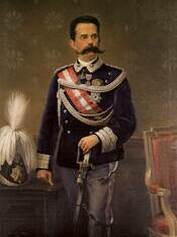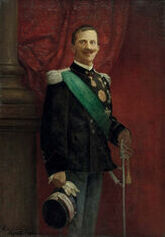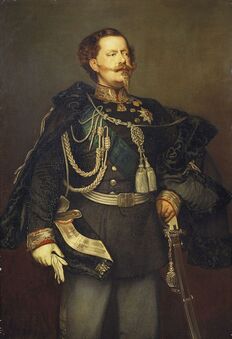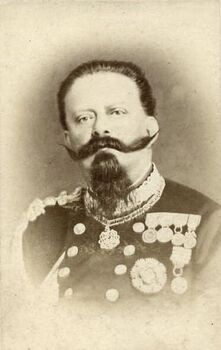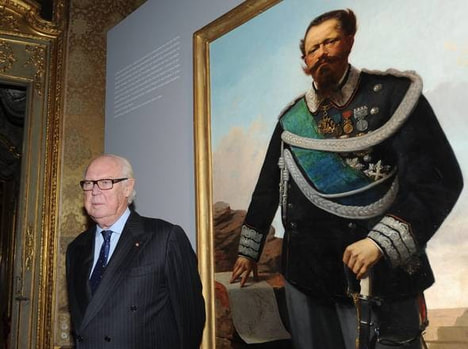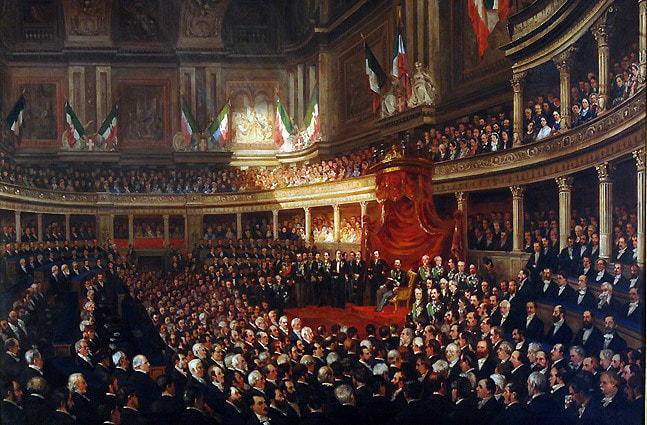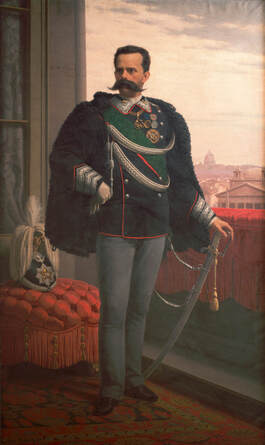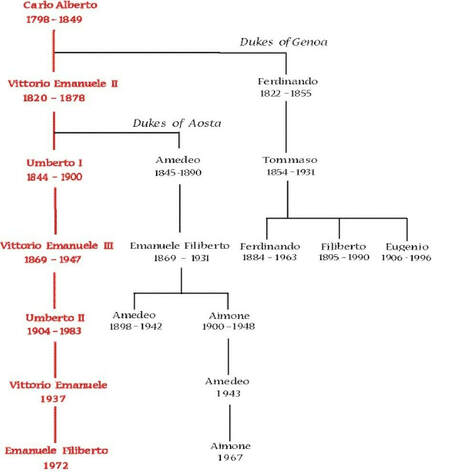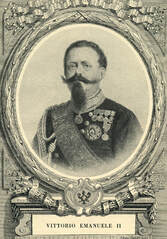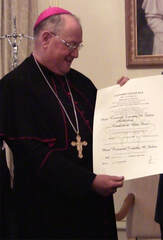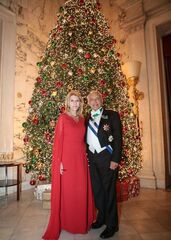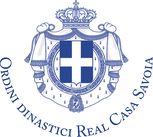American Delegation of Savoy Orders
Unification of a Nation: The Kings of Italy (1861-1946)
|
|
Cavour continued to plan for the elimination of the Bourbon dynasty in the Two Sicilies and to absorb it into the new nation. King Ferdinand II had died in 1859 and was succeeded by his young untried son, King Francis II. Cavour secretly planned and funded a military expedition from Genoa led by Giuseppe Garibaldi with thousands of "red shirted" followers to invade Sicily. Piedmontese agents had quietly bribed leading Neapolitan officials to betray their sovereign at the appointed hour. Garibaldi and his followers landed in Sicily and quickly seized the island from the Bourbon forces. The Bourbon army was weakened by the inertia of its high command, which had been compromised. By 1860 Garibaldi's forces crossed the Straits of Messina onto the mainland where there were skirmishes en route to Naples. Francis abandoned the capital on the advice of his military advisors and engaged Garibaldi's forces at the Volturno. Events were moving too quickly and the Piedmontese intervened to corner the Bourbon forces. Francis thereafter retreated to a courageous defense at the citadels of Gaeta on the sea and Civitella del Tronto in the Abbruzzi. Victor Emmanuel entered the Two Sicilies where he met Garibaldi, who ceded his authority as Dictator to the King. By 1861, the courageous remnants of the Bourbon Army that remained loyal to their King honorably surrendered after a devastating siege at Gaeta and Civitella and King Francis and Queen Maria Sofia were transferred to a French corvette to exile without abdicating. A fierce guerilla war followed for almost a decade that forced the deployment of over 75,000 Piedmontese soldiers in the Two Sicilies to maintain order as the remnants of the Bourbon Army and a recalcitrant segment of the populace fought the new régime. Referendums were quickly held and the incorporation of the Two Sicilies into the new Kingdom of Italy was ratified. King Victor Emmanuel II was proclaimed King of a united Italy on February 18, 1861. After the fall of Rome in 1870, the Papal capital became the seat of the new Kingdom. It was in Rome that Victor Emmanuel II died on January 9, 1878 and was buried in the Pantheon. His eldest son, Humbert I, assumed the title of King of Italy. Of his other sons, Amadeus, Duke of Aosta, was briefly elected King of Spain and then returned to Turin when the Spanish changed their minds. The youngest, Thomas, succeeded as Duke of Genoa. Clothilde had been sacrificed to the Bonaparte clan but his other daughter, Maria Pia, fared much better by marrying King Louis of Portugal. The Second King of Italy, Humbert I (1844-1900), married his cousin, Princess Margaret of Savoy-Genoa. Well liked and approachable, he instituted many public reforms and was concerned about the fate of the working classes and labor conditions. He was assassinated by an anarchist during a sporting event in Monza on July 29, 1900 and was given an emotional funeral at the Pantheon. Induno (Life time: 1815-1878) - Original publication: Cerimonia di insediamento del nuovo Parlamento Immediate source: http://www.difesa.it/Primo_Piano/Pagine/LeCapitalidellUnitanazionale.aspx |
|
Young King Victor Emmanuel III (1869-1947) succeeded his assassinated father as the Third King of Italy. Four years earlier he had married Princess Elena of Montenegro. He inherited a liberal constitutional monarchy and was determined to carry out the attachment of his late father to those principles. But Italy was politically fragmented and faced many challenges that made the parliamentary debates at times chaotic and uncertain. Slowly the nation commenced a course of measured economic development and stability. That was shattered by the cataclysm of World War I. A member of the Triple Alliance, Italy remained neutral until 1915 and then joined the Allies. As a consequence of its participation, Italy received Trieste and the Trentino region from Austria at the Peace Conference of Versailles. Unstable revolving governments, a weakened global economy and unrealized nationalist expectations resulted in an atmosphere of discontent. On October 28, 1922, Benito Mussolini and his black shirts marched on Rome. Confronted with this harsh reality, the King had the choice of either declaring martial law and risking a potentially violent confrontation between a shaky military and his own people or accepting Mussolini as his prime minister and asking him to form a government. The King opted for the latter. Mussolini and the Fascists quickly consolidated their power and over the years moved to marginalize the monarchy. The King, as a constitutional monarch, ratified the steps taken by Mussolini to alter the liberal state created by his father. By 1939, the King's role had been substantially diminished under Fascism. He had been granted the hollow titles of King of Albania and Emperor of Ethiopia but never visited those realms. World War II saw Mussolini guide Italy into the alliance with Germany and mass destruction and devastation ensued. By 1943, the King conspired against the Prime Minister and led a coup that removed Mussolini on July 23. He then commanded Marshal Pietro Badoglio to conclude an armistice with the Allies. On October 13, 1943, the King declared war on Germany. But the residual harm to the monarchy as a result of the Fascist years took its toll, and, on April 12, 1944, the King announced his "irrevocable" decision to withdraw from public life "on the day on which Allied troops entered Rome." Then on June 5, 1944, at Ravello, the King nominated the Prince of Piedmont, his son Crown Prince Humbert, as Lieutenant General of the Realm, retaining his title as head of the House of Savoy and remaining as King without power. The action was too little too late. Victor Emmanuel eventually abdicated on May 9, 1946, and went into self-imposed exile in Egypt, where he died on December 28, 1947. He was temporarily buried in the Cathedral of St. Catherine in Alexandria. Queen Elena returned to Montpelier where she died on November 28, 1952. |
|
Royal House of Savoy Family Tree |
The Fourth King of Italy, Humbert II (1904-1983), was a bright and capable man, whose misfortune was that he did not have sufficient time to rectify the damage to the monarchy that had been done by others. A liberal and constitutionalist, he had married Princess Maria Jose of Belgium, only daughter of King Albert I of the Belgians, the "Soldier-King", and Princess Elizabeth of Bavaria. Both were leading anti-Fascists and detested by Mussolini. He became King on May 9, 1946 and immediately had to contend with a referendum on the monarchy to take place on June 2-3, 1946. There was scant time for him to reign. Execution of the referendum was far from perfect and fraught with irregularities that raised questions about the validity of the outcome in the minds of many who witnessed it. Nonetheless, by a reported narrow majority a republic was created to replace the monarchy. The King could have contested the results but to do so would only have caused more agony for war-ravaged Italy. King Humbert II took the path of exile that was chosen by his ancestor, King Charles Albert, and departed for Portugal without abdicating. He remained there until 1982 when his health compelled him to move to Geneva, where he died on March 18, 1983. He remained close to his country for all the long years of exile and his door was always opened to any Italian who wished to visit him. His last word was "Italia". He was interred in a private chapel at the traditional burial site for the early Counts of Savoy, the Abbey of Hautecombe, situated on the shore of Lake Bourget in what is now the French province of Savoy, where he was later joined by his wife, Queen Maria Jose after her death on January 27, 2001, at the age of 94. |
Royal House |
History |
Orders |
Members |
News & Events |




